Lund 2075 Pro-V: Commando Fishing is Here!
If you thought the only color Lund aluminum boats came in was olive green, then we’ve got news for you – the new Lund 2075 Pro-V comes in commando black. We have seen Lund boats parked along gravel shores from Grise Fiord on Ellesmere Island just 1500 miles south of the North Pole, to Iquitos, Peru at the headwaters of the Amazon, just a few hundred miles south of the Equator; and that is just in the Western Hemisphere. These boats must have something going for them. For more than 60 years, Lund Boat Company has been building some of the best small aluminum boats on planet earth, and now they’re testing their metal by building a serious multi-species fishing boat.
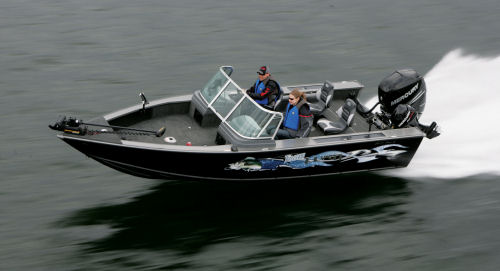 For the special breed of determined angler, the Lund Boat Company has created the remarkable 2075 Pro-V – which is nothing short of a angler’s commando craft. |
Captain’s Report by Mike Smith
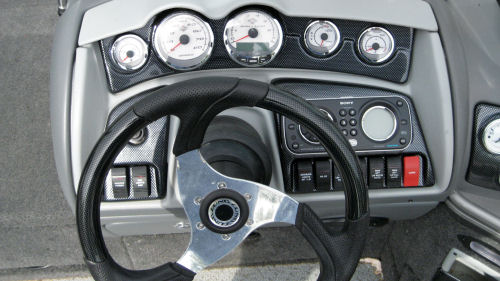 The 2075 Pro-V comes with either dual consoles, in the IFS/SE version, or a single console in the SE version. Both set-ups include full instrumentation that are easy to read at a glance. A Sony stereo/CD is standard. |
Possibly there is no major stretch of geography in the world that is more perilous for a small boat than the great northern reaches of the North American continent. There boating can be hazardous even on bright, sunny days. Logs washed down from the forests to the sea waiting like dormant torpedoes can easily punch a hole in a speeding powerboat. Go far enough north, and you can run into ice in the middle of August – even mini-ice bergs the size of a basketball are as hard as concrete when you hit them.
Unlike other parts of the world, if you get into serious trouble in the far north, you could be orca-bait by the time help arrives. And what kind of boats do folks in those parts prefer? Aluminum ones; and as likely as not, they will be made by Lund. Maybe there’s a lesson here for the rest of us -- a lesson Howard Lund started teaching back in 1948.
The Back Story
After World War II, G. Howard Lund was living in New York Mills, a community in central Minnesota with a strong Scandinavian and German heritage. Even today it’s a small town of about 1,200 people, its economy based on agriculture and the Lund Boat Company. There are also more than a thousand lakes nearby; lakes mean fishing, and fishing means boats.
And like the far reaches of Canada, Minnesota and much of the Midwestern U.S. was scraped down to bare rock by the last great Ice Age. That’s what gave us the Great Lakes and most of the rest of the tens of thousands of lakes in this fisherman’s paradise of a continent.
In 1948, Lund built himself a small duck boat – not out of wood, but riveted aluminum. It was light and easy to put on top of a car, and that’s where the boat was when a salesman from Inland Marine Corporation saw it. He found Lund’s address, visited him at home and asked where he could get a boat like it. Lund said he would build him one; the man asked if he would build him 50, and the Lund Boat Company was born.
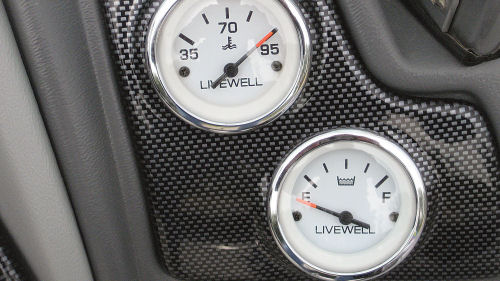 The instrument package includes water temp and level gauges for the aft livewell. A second livewell is forward. Lund equips all three versions of the 2075 Pro-V for serious fishing, including a fishfinder and lots of lockable rod stowage. |
Lund built the first boats in his garage, soon moving to a new building and hiring 15 employees. Today Lund Boat Company has over 500 workers on a 29-acre facility. Yes, they still build duck boats – check out their Jon Boat Series – but also a wide variety of fishing and sport boats; there’s now even a line of fiberglass Lunds. But when most of us think “Lund,” we think “aluminum.”
Also, when we think of Lund we think of that brand as the Ranger Rover of its class.
Now, the boat that is at the top of the Lund line is the 2075 Pro-V, intended for the very serious fisherman, the guy who thinks fishing ranks #1 on Maslow’s hierarchy of his needs.
How is an Aluminum Boat Built?
Large aluminum boats, built of thick plate, are usually welded together, but smaller boats with thinner plate can be welded or riveted. Each method has its proponents, and both can produce excellent boats. Lund believes in rivets.
The 2075 Pro-V is double-riveted along the seams, which the company says is stronger than welding. Next time you’re on an airplane, look at the wing: It’s riveted, not welded, so maybe the Lund folks know whereof they speak. Other joints are single-riveted or, in some areas, welded. In high-stress or high-abuse areas, the plating is double thickness.
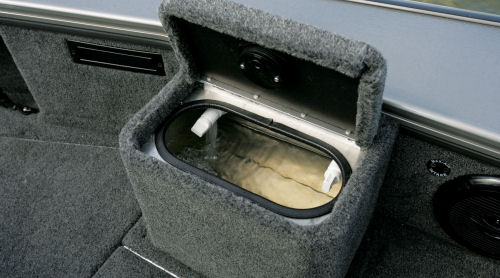 Nothing special about this livewell – except the plush carpet Lund uses to cover the 2075 Pro-V’s livewell, in addition to the deck. Carpet is easy on the feet and provides good footing. The marine-plywood deck underneath is covered by a lifetime warranty. |
A Riveting Story
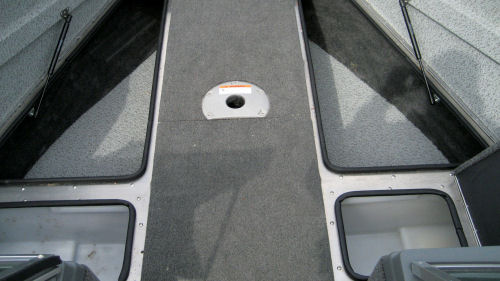 Lund builds its decks with marine-grade plywood covered with long-wearing carpet. There’s lots of under-deck stowage, as you can see here. Note that the inside of the aluminum hull is nicely finished – you don’t see bare metal and structure. |
The aluminum skin must be supported by a well-designed interior structure. Unlike wooden boats, whose main frames are transverse athwartships, metal hulls rely primarily on longitudinal framing, running from end to end of the hull, tied into bulkheads, interior structure and minimal transverse framing. (There are far fewer transverse frames than you’ll find on a wooden boat, though).
The result is a solid structure that’s also lightweight. Some builders use edge-welded flat bar for longitudinals, but Lund uses riveted I-beams to support the bottom, making it stiff and rigid – even more so when the tanks, injected foam flotation and marine-grade plywood deck are installed.
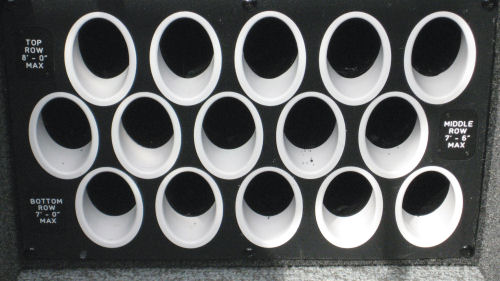 Keep 15 of your rods safe in this slide-in stowage locker between the under-deck lockers shown above. It will handle rods up to 8’, and is lockable. |
The Force Is Behind You
The longitudinal I-beams are tied into the transom, which is further supported by aluminum knees. Why? Bass-crazed fisherman bolt big outboards to their boats so they can race from fishing hole to fishing hole faster than the next guy. Maximum power for the SE and IFS/SE versions of the 2075 Pro-V is a 300XL Mercury Verado.
A third variation, called simply Tiller, is limited to a Merc 250-hp Pro XS outboard. Rather than a helm console, this version steers with Mercury’s power-assisted Big Tiller handle, with integrated throttle, shift and trim controls. This leaves almost the whole boat open for fishing – there’s no helm in the middle to get in the way. You are talking serious angling here.
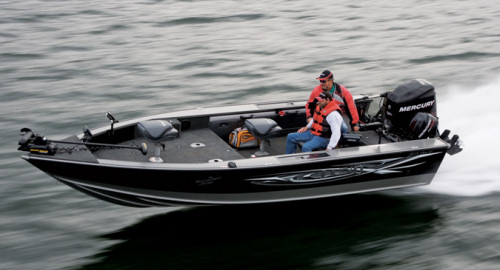 The Tiller version of the 2075 Pro-V lets you steer from the stern (there’s power assist) and keep the rest of the boat clear for angling. We’d feel more secure in a helm seat, but when we were kids we raced all over the bay hanging off the tiller of an outboard – remember? |
Matching small boats with big power requires a good hull design; even the best boats can get squirrely at the speeds we’re talking about here. Lund starts with a basic deep-V, but modifies it with a flatter “power strake” and reverse chines; the Pro-V has a deeper V and intermediate running strakes, too. Lund calls this design IPS, and says it adds top speed, keeps the boat on-plane at lower speed, improves handling, makes the boat drier, boosts fuel efficiency and shortens hole-shot time.
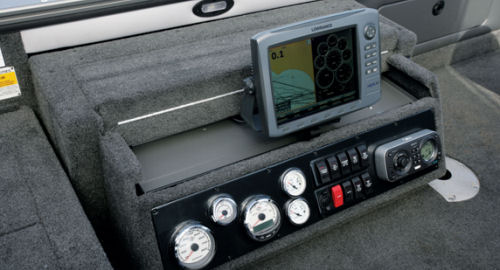 The Tiller version of the 2075 Pro-V lets you steer from the stern (there’s power assist) and keep the rest of the boat clear for angling. We’d feel more secure in a helm seat, but when we were kids we raced all over the bay hanging off the tiller of an outboard – remember? |
When Speed Counts
When it comes to tournament fishing, speed and handling are important to competitive fishermen, along with the ability to keep going fast even if it’s windy and choppy: Fish, and prize money, don’t wait for better weather. While the 2075 Pro-V isn’t a big-water speedboat, for its intended use it should be more than capable.
While we have not tested the boat yet, our bet is that its aluminum construction will outlast the human skeleton in rough water. Any sensible fisherman will throttle back to save his spine long before the metal-clad Lund cries Uncle. Although when he smells a trophy bass or walleye, what fisherman is “sensible?”
World-Class Warranty
Lund supports the 2075 Pro-V with a transferable Lifetime Limited Warranty on hull materials and workmanship; it includes all plywood panels, related materials and labor. For three years, the boat is also covered by a 100% bow-to-stern parts and labor warranty. Yes, there are a few exclusions; a Lund dealer will give you the particulars.
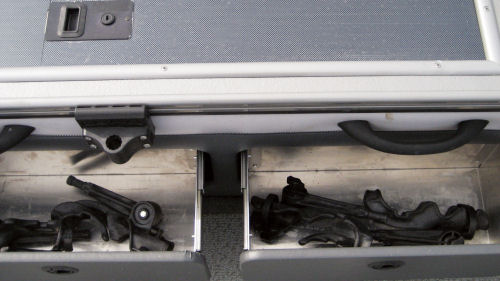 Drawers under the gunwale hold lots of small gear; we have no idea what’s in these, but we’d keep a dry pair of shoes, maybe socks, too, in chilly weather. Or, you might want to pack small tools, or any of the other 1,001 things you need on a boat. The sliding door above the drawers is another rod locker, to keep rigs you’re using off the deck and out from underfoot. It’s lockable, too. |
At What Price Glory?
So what’s the bottom line? Metal-heads will tell you the advantages of aluminum far outweigh those of fiberglass, no matter what the cost. The IFS/SE version of the 2075 Pro-V starts at $46,740 with a 150XL Optimax, increasing to $59,714 with the 300XL Verado. Prices include the prop, but not pre-rigging for the Verado. There are many engine options between these two. A trailer is included, too, along with most everything you need to go fishing, except rods, reels and lures. We estimate a well-set-up boat with 250 horsepower and a few options will run about $60,000 MSRP, give or take.
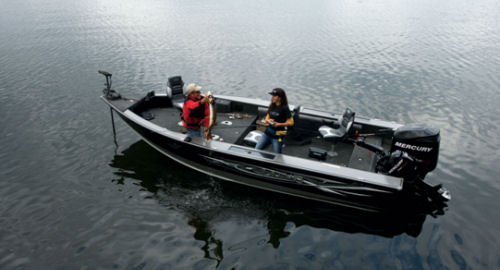 Looks like fun to us. The Tiller version makes a perfect platform for a lazy afternoon’s fishing. And when they stop biting, fire up the Mercury and race across the bay or lake to a better spot. Sure beats working. |
Recommendation
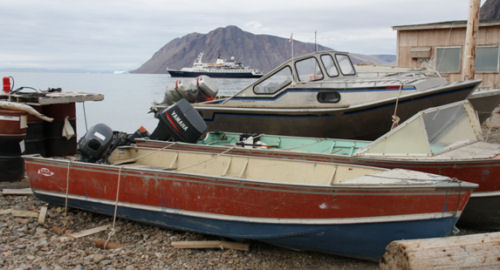 There are two Lunds in this photo taken in Grise Fiord, Ellesmere Island, Canada last August. Both are owned by Inuit fishermen who understand the benefits of aluminum in the high Artic. |
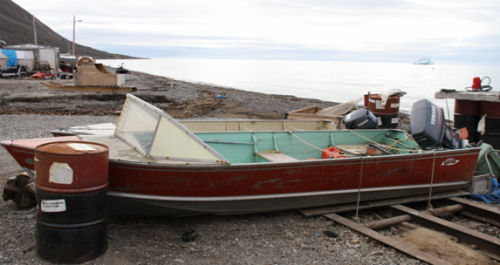 View of the second Lund with a little aftermarket customization. Grise Fiord was settled in the early 1950s by Inuit from Hudson Bay who were bamboozled by the Canadian government. This settlement of 146 souls is the most northerly civilian village on the planet. If you are interested in the true story of Grise Fiord during Cold War madness, read “The Long Exile.” |
As far as engine size goes, how fast do you really need to go? The days when wild-eyed boaters went screaming across a like looking for someone else to drag race are over. Regular readers know that we think zipping across a lake at 60 mph is a waste of fuel and increases one’s chance for an accident. The standard engine on the 2075 Pro-V is a 150-hp Merc which should propel this boat in the mid-40 mph range. With that engine the boat costs about $46k MSRP. If you want to go in the high 50s, or maybe 60 + mph, the 250 Mercs should do that, and you will pay for the pleasure.
Ok, but there are many aluminum fishing boats on the market that are a lot less money than the Lund 2075 Pro-V. We could say the same thing about a Range Rover or Cadillac yet many people buy them, rather than a KIA or Chevy. So, if you are the kind of boater who is happiest with the classiest aluminum rig on the water, then you should give this boat a good look.
And if you are wondering about Lund durability, ask an Inuit in Grise Fiord.